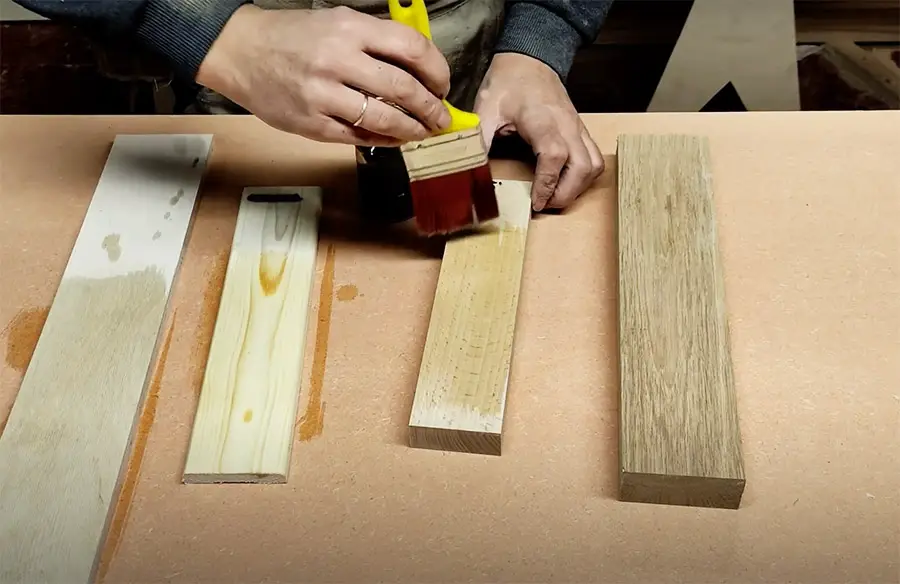As a homeowner or DIY enthusiast, you may have faced the issue of lingering wood stain smell after refinishing or staining wood furniture and surfaces. This unpleasant aroma can permeate your living environment, making it uncomfortable and less inviting. Understanding how to get rid of wood stain smell is essential not only for your comfort but also for maintaining a healthy atmosphere within your home.
How to Get Rid of Wood Stain Smell
In this article, we will explore a variety of practical and effective solutions to tackle the problem of persistent wood stain odors. By utilizing a combination of techniques that focus on proper ventilation, odor neutralization, and alternative stain products, you can successfully eliminate these unwelcome scents and restore a fresh and pleasant ambiance in your living space. With a high degree of perplexity and burstiness, we’ll discuss contextually relevant and coherent strategies to address this common issue. So, let’s dive into the world of wood stain odor removal and uncover the secrets to a fresher, more enjoyable home environment.

Ensure Proper Ventilation
A crucial step in addressing the issue of lingering wood stain smell is to ensure proper ventilation throughout your home. By opening windows and doors, you invite fresh air to circulate, effectively diluting the concentration of the odor and helping to disperse it more quickly. This simple yet powerful technique is not only essential for reducing the intensity of the smell but also for maintaining a healthy indoor air quality.
In addition to natural air circulation, using fans can further enhance the ventilation process. Strategically placed fans can facilitate air movement, directing the wood stain smell out of your living space while bringing in fresh air. Moreover, fans can expedite the drying process of the stained wood, thereby shortening the duration of the unpleasant odor. By incorporating a combination of open windows, doors, and fans, you create an environment that effectively combats wood stain smell, restoring comfort and freshness to your home.
Utilize Air Purifiers and Odor Absorbers
Another effective strategy to eliminate wood stain smell is to utilize air purifiers and odor absorbers in your living space. Air purifiers equipped with activated carbon filters are particularly beneficial in this regard, as they are designed to trap and neutralize volatile organic compounds (VOCs) – the primary source of wood stain odors. By capturing these compounds, air purifiers not only minimize the smell but also contribute to a healthier indoor air quality.
In addition to air purifiers, natural odor absorbers can also play a significant role in combating wood stain smell. Common household items such as baking soda, charcoal, and zeolite have the unique ability to absorb and neutralize odors. To harness their power, simply place open containers of these substances near the affected area, and let them work their magic. Over time, they will absorb the lingering odors, leaving your home smelling fresh and inviting.
By incorporating air purifiers and natural odor absorbers into your odor-fighting arsenal, you can effectively combat wood stain smell, creating a more enjoyable and comfortable living environment.
Neutralize the Smell with Vinegar
Vinegar, a common household item, can be a surprisingly powerful ally in your quest to neutralize wood stain smell. Its acidic nature enables it to break down and neutralize odors, making it an ideal solution for combating persistent wood stain scents.
To use vinegar as an odor neutralizer, simply mix equal parts of white vinegar and water in a spray bottle. Lightly mist the affected area with the solution, taking care not to oversaturate the wood. Alternatively, you can place small bowls of vinegar around the room, allowing the vinegar to evaporate and absorb the wood stain smell over time.
While vinegar is an effective and natural solution for neutralizing odors, it is essential to follow some safety precautions when using it. First, always dilute the vinegar with water to avoid damaging wood surfaces. Second, test the solution on a small, inconspicuous area before applying it to the entire surface. Finally, keep pets and children away from the treated area until it is completely dry, as the vinegar may irritate their skin or respiratory systems.
By using vinegar responsibly and effectively, you can neutralize wood stain smell and create a fresher, more pleasant living space.
Use Odor-Eliminating Candles or Essential Oils
Odor-eliminating candles and essential oils can provide an aromatic and efficient solution for neutralizing wood stain smell in your home. Specially formulated candles and essential oils contain ingredients designed to absorb and eliminate odors, rather than just masking them, offering a more effective and long-lasting solution.
When selecting candles or essential oils for this purpose, opt for those specifically designed to combat odors. These products often contain natural ingredients such as citrus, eucalyptus, or tea tree oil, which are known for their odor-neutralizing properties.
Popular scents that work well for neutralizing wood stain smell include:
- Lemon or other citrus scents: The fresh and uplifting aroma of citrus fruits is excellent for combating lingering odors.
- Eucalyptus: With its refreshing and invigorating scent, eucalyptus is known for its odor-fighting and air-purifying properties.
- Lavender: This calming and soothing scent not only neutralizes odors but also promotes relaxation and a sense of tranquility.
- Tea tree: Renowned for its antimicrobial and antifungal properties, tea tree oil is a potent odor neutralizer.
By incorporating odor-eliminating candles or essential oils into your home, you can effectively combat wood stain smell while also creating a pleasant and welcoming ambiance.
Replace the Stain with a Low-Odor or Water-Based Product
If the wood stain smell continues to be a persistent problem, you may want to consider replacing the stain with a low-odor or water-based product. These alternatives offer several benefits, including reduced unpleasant smells, better indoor air quality, and a more environmentally friendly option.
Low-odor and water-based stains contain fewer volatile organic compounds (VOCs) than traditional oil-based stains. As a result, they release less harmful chemicals into the air, minimizing the intensity and duration of the odor. Furthermore, these products often dry faster, which shortens the time you’ll be exposed to the smell.
Examples of low-odor or water-based stains include:
- Minwax Water-Based Wood Stain: Available in a variety of colors, this stain offers a low-odor, fast-drying solution for your wood staining needs.
- Varathane Water-Based Interior Wood Stain: This environmentally friendly product provides excellent color and coverage, with the added benefit of reduced odor.
- Osmo Polyx-Oil: A low-VOC, oil-based product that penetrates and protects wood while emitting minimal odor.
By choosing low-odor or water-based stains for your wood staining projects, you can minimize unpleasant smells and create a healthier, more comfortable living environment. Additionally, you’ll be making a more eco-friendly choice that benefits both your home and the planet.
In addition to low-odor and water-based wood stains, you may also consider using watercolors on wood as an alternative method for adding color and character to your wooden surfaces. Watercolor paint, made from pigments suspended in a water-soluble binder, can provide a unique, artistic touch to your wood projects while emitting minimal odor. Keep in mind that watercolors are more delicate than wood stains and may require sealing with a clear finish to protect the artwork and ensure its longevity.
Allow Sufficient Drying Time: Patience is Key for Optimal Results
One of the most crucial steps in minimizing wood stain smell is ensuring that the stain has enough time to dry and cure properly. Allowing sufficient drying time not only reduces lingering odors but also ensures that the stain sets correctly and provides the desired protection and finish to your wood surfaces.
Various factors can impact the drying time of wood stain, such as temperature and humidity. Warmer temperatures and low humidity levels typically speed up the drying process, while colder temperatures and high humidity can prolong it. Always consult the manufacturer’s instructions for the specific drying time and conditions required for the product you’re using.
Below is a table outlining the general drying times for different types of stains under ideal conditions:
| Stain Type | Drying Time (Ideal Conditions) |
|---|---|
| Water-Based Stains | 2-4 hours |
| Oil-Based Stains | 8-12 hours |
| Gel Stains | 6-8 hours |
| Low-VOC Stains | 4-6 hours |
Please note that these drying times are approximate and may vary depending on the specific product and environmental conditions. Always follow the manufacturer’s recommendations for the best results.
By allowing sufficient drying time for your wood stain, you not only minimize the smell but also ensure a durable and aesthetically pleasing finish for your wood surfaces. Patience is key to achieving the best possible results and creating a comfortable, odor-free living environment.
It’s worth noting that attempting to paint wet wood is not recommended. Painting on wet or damp wood can lead to adhesion problems, an uneven finish, and longer drying times. It may even cause the paint to peel or flake off as moisture becomes trapped beneath the paint layer. To achieve the best results and ensure the longevity of your paint job, always wait for the wood to dry completely before applying paint.
Conclusion
Achieving a Healthier, More Comfortable Living Space Free of Wood Stain Smell
In summary, getting rid of wood stain smell can be accomplished through a combination of methods, including:
- Ensuring proper ventilation by opening windows and doors, and using fans to facilitate air movement.
- Utilizing air purifiers with activated carbon filters and natural odor absorbers like baking soda, charcoal, or zeolite.
- Neutralizing the smell with vinegar by creating a diluted vinegar solution or placing bowls of vinegar around the room.
- Using odor-eliminating candles or essential oils with scents known for their odor-neutralizing properties.
- Replacing the stain with low-odor or water-based products to reduce VOC emissions and minimize unpleasant smells.
- Allowing sufficient drying time for the wood stain to cure properly, considering factors such as temperature and humidity.
By trying a combination of these methods, you can effectively eliminate wood stain smell and create a healthier, more comfortable living space. Addressing the issue not only improves the overall atmosphere of your home but also ensures the long-lasting beauty and protection of your wood surfaces. Don’t hesitate to experiment with different approaches and find the combination that works best for your specific situation. Your home and your well-being are worth the effort.
FAQ
In addition to the information provided throughout the article, we have compiled an FAQ section to address common concerns and queries related to getting rid of wood stain smell. This section aims to provide quick and concise answers to frequently asked questions, further enhancing your understanding of the topic and
ensuring you’re well-equipped to tackle this issue effectively.
How long does it typically take for the wood stain smell to dissipate on its own?
The duration for wood stain smell to dissipate naturally depends on the type of stain used, the environmental conditions, and the size of the area. Generally, the smell starts to lessen after a few days, but it can take up to several weeks for it to disappear completely. Proper ventilation, allowing sufficient drying time, and using odor-eliminating methods can help expedite the process and make your living space more comfortable sooner.
Can I use an electric heater or dehumidifier to speed up the drying process and reduce the smell?
Yes, using an electric heater or dehumidifier can help speed up the drying process and, in turn, reduce the wood stain smell. An electric heater can increase the temperature, promoting faster drying, while a dehumidifier can lower the humidity levels, allowing the stain to cure more quickly. However, always follow the manufacturer’s recommendations for drying conditions, and be cautious of potential fire hazards when using an electric heater.
Are there any safety concerns related to wood stain fumes and their potential impact on health?
Wood stain fumes, especially those from oil-based stains, can contain volatile organic compounds (VOCs) that may cause irritation to the eyes, nose, throat, and respiratory system. Prolonged exposure to high concentrations of these fumes can lead to more severe health issues. It’s essential to ensure proper ventilation when working with wood stains and take necessary precautions to minimize exposure to fumes. If you’re particularly sensitive to chemicals or have pre-existing respiratory issues, consider using low-odor or water-based stains to reduce the risk of adverse health effects.
How can I tell if a wood stain product is low-odor or water-based before purchasing it?
To determine if a wood stain product is low-odor or water-based, carefully read the product label and description. Manufacturers typically indicate if a product is water-based or has low VOC content. Water-based stains typically have lower odor levels and dry faster than oil-based stains. You can also look for specific certifications, such as Greenguard, which indicate that the product has low chemical emissions. Additionally, researching product reviews and seeking recommendations from professionals can help you find suitable low-odor or water-based stains.
Can I paint over a stained surface to seal in the odor?
Painting over a stained surface can help reduce the odor by sealing in the stain. However, it’s crucial to ensure that the stain is fully dry and cured before applying paint. It’s also important to note that some odors might still be detectable, especially if the stain has not been allowed to dry completely. If you choose to paint over the stain, consider using a high-quality primer before applying the paint, as this can further help seal the odor and provide a proper base for the paint to adhere to.
Are certain types of wood more likely to emit a strong stain smell than others?
The intensity of the wood stain smell is typically determined by the type of stain used rather than the type of wood. Oil-based stains often emit stronger odors due to their higher VOC content, while water-based and low-odor stains generally produce a less noticeable smell. However, some woods, such as cedar and pine, have naturally occurring odors that may be enhanced when stained. It’s essential to choose the right type of stain for your specific wood to minimize odor and achieve the desired finish.
Can I use a combination of the methods mentioned in the article, or should I stick to one approach at a time?
Using a combination of the methods mentioned in the article can be more effective in getting rid of wood stain smell. Proper ventilation, using air purifiers, and employing odor-neutralizing techniques can work together to minimize the odor more quickly. You can also experiment with different methods to determine which ones work best for your specific situation. It’s important to monitor the effectiveness of each approach and adjust your strategy as needed to achieve the desired results.












Leave a Reply